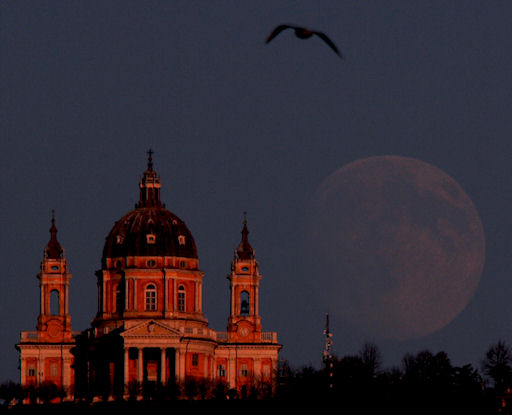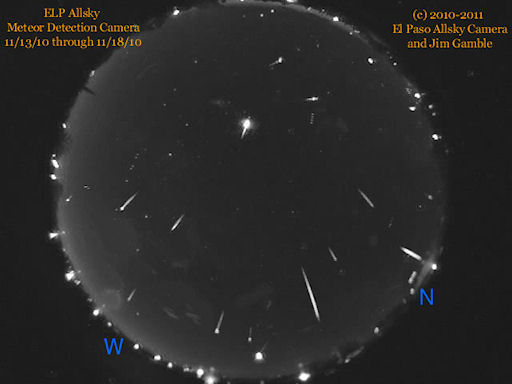COMET SNOWSTORM ENGULFS HARTLEY 2: Researchers have released new and beautiful photos of an unprecedented snowstorm raging around Comet Hartley 2. "We've never seen anything like it," says science team leader Michael A'Hearn of the University of Maryland. Get the full story from Science@NASA.
OLD-FASHIONED BLUE MOON: According to modern folklore, a Blue Moon is the second full Moon in a calendar month. The next Blue Moon to fit this description will come on August 31, 2012. Do we really have to wait so long? There is an older definition that says the next Blue Moon is this weekend. To prepare for the event, Stefano De Rosa snapped this picture of the Moon waxing full over Turin, Italy:

The Moon is full on Nov. 21st. Usually there are only three full Moons in a season, but this Fall there will be four. The full Moon of Nov. 21st is the third of those four. According to old editions of the Maine Farmer’s Almanac, that makes it a Blue Moon. Confused? No wonder the modern definition is so much simpler.
"We have bad weather forecast for the 21st," says De Rosa, "so I took my old-fashioned Blue Moon photo on the 19th instead. It might not be truly blue, but the Moon looked great anyway rising alongside the Superga church while another wonder from the sky was joining the scene!"
Readers, be alert on Sunday night for a Blue Moon of your own.
more images: from Saied Bahrami Nejad of Kerman, Iran; from Guillaume Cannat of Prades-le-lez, France; from Tom Wagner of Waterloo, Iowa
LEONID RECAP: Earth is exiting a thicket of debris from Comet Tempel-Tuttle, source of the annual Leonid meteor shower. According to international counts, the shower crested on Nov. 17th and 18th with a peak rate of 20 meteors per hour. Compared to, say, the Leonid storms of a decade ago, it was not an impressive display--that is, unless you added it up for five nights in a row:

"These are all the Leonid fireballs I recorded from Nov. 13th to Nov. 18th," says Jim Gamble, who operates an all-sky camera in El Paso, Texas. "In total, there were 16 Leonids of magnitude -3 or brighter." Considering that Earth missed the densest part of the Leonid debris stream in 2010, more than a dozen fireballs is a good haul.
A bigger display is coming: In early December, Earth will enter a cloud of debris from extinct comet Phaethon, setting off the annual Geminid meteor shower. On peak night, Dec. 14th, forecasters expect as many as 100 meteors per hour, five times greater than the waning Leonids. Stay tuned!
more images: from Yuichi Takasaka of Gingolx (Kincolith), British Columbia, Canada; from Thomas Kerns of Homer, Alaska; from Yaron Eini of Jerusalem, Israel;
November 2010 Aurora Gallery
[previous Novembers: 2009, 2008, 2007, 2006, 2004, 2003, 2002, 2001, 2000]
Potentially Hazardous Asteroids (
PHAs) are space rocks larger than approximately 100m that can come closer to Earth than 0.05 AU. None of the known PHAs is on a collision course with our planet, although astronomers are finding
new ones all the time.
On November 20, 2010 there were 1164 potentially hazardous asteroids.
Notes: LD means "Lunar Distance." 1 LD = 384,401 km, the distance between Earth and the Moon. 1 LD also equals 0.00256 AU. MAG is the visual magnitude of the asteroid on the date of closest approach. | | The official U.S. government space weather bureau |
| | The first place to look for information about sundogs, pillars, rainbows and related phenomena. |
| | Researchers call it a "Hubble for the sun." SDO is the most advanced solar observatory ever. |
| | 3D views of the sun from NASA's Solar and Terrestrial Relations Observatory |
| | Realtime and archival images of the Sun from SOHO. |
| | from the NOAA Space Environment Center |
| | the underlying science of space weather |

